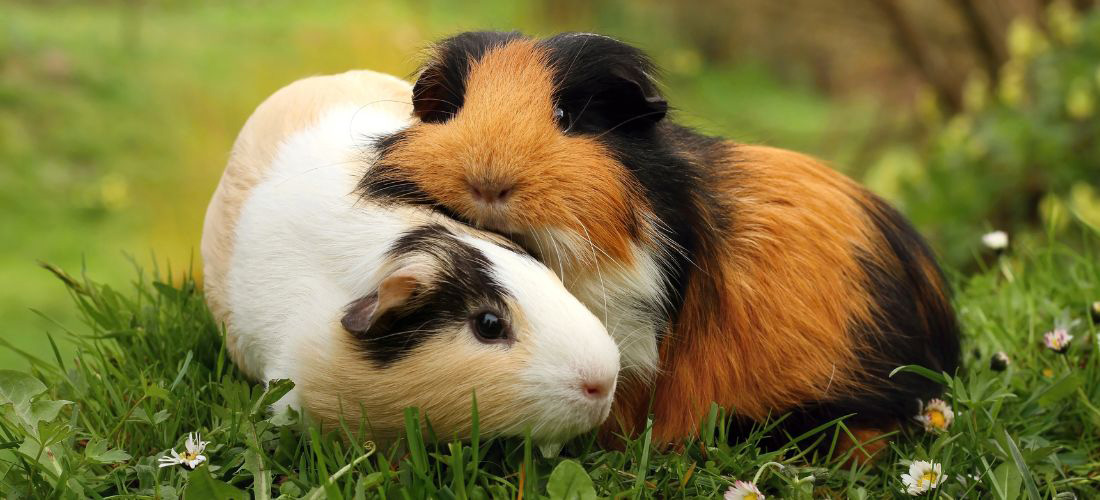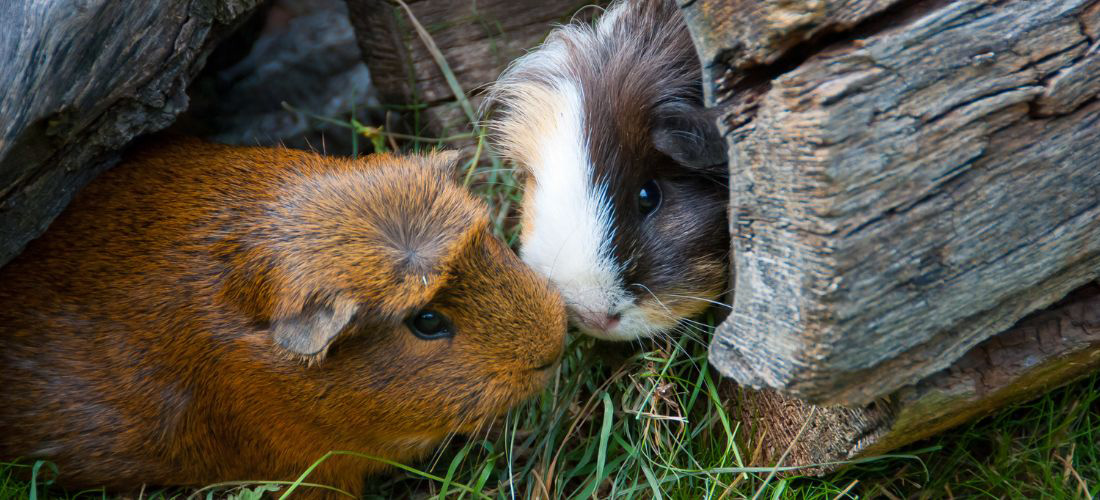To stay happy and healthy, guinea pigs need access to:
- Clean water.
- A variety of guinea pig safe vegetables.
- A small amount of guinea pig complete food pellets.
- An endless supply of hay.
- A same sex or neutered guinea pig companion.
- Plenty of space to exercise.
- Several places to hide.
If you’re new to guinea pigs, or simply want a refresher on how to give them the best life possible, here are five common health problems to look out for.
1. Overgrown nails
Guinea pigs need regular nail trims and feet checks as their nails never stop growing. If nails are left to grow too long, they can curl round and grow into the soft pads of the feet which is not only painful but can also cause infection and stop guinea pigs being as mobile as they should be. Not being active could also cause other health issues down the line.
One of the biggest fears owners have when trimming their guinea pigs’ nails is catching the quick - a blood vessel that runs through each nail. Although it’s a scary task, letting your guinea pigs’ nails grow beyond a comfortable length will cause painful problems for them if left untreated. If you’re worried about trimming your guinea pigs’ nails yourself, ask your vet or vet nurse to do them for you.
Guinea pigs can also develop painful pressure sores on their feet, a condition known as bumblefoot (pododermatitis). This foot condition is mostly seen in guinea pigs that are overweight, aren’t very active, or are housed on tough or wire-bottomed cages, however it can also be caused by long nails which damage your pigs’ foot pads.
They can also get spurs (calluses) on their feet which sometimes require attention. Spurs can become painful, stop your guinea pigs from walking around, or could get caught on things – which might be stressful and painful for the guinea pig. Like nails, spurs can also be trimmed, but your vet will need to help you with this to avoid catching any sensitive areas.

2. Upper Respiratory Infections
A condition that vets often see in guinea pigs is upper respiratory infections (URI). This illness affects your pet’s respiratory (breathing) system (lungs, nose, airways) and can quickly become fatal if left untreated. Although some of the symptoms of a URI may seem like a cold or flu, it’s much more serious for guinea pigs and won’t go away on its own – you need to make sure they see a vet as soon as you notice symptoms.
Symptoms of upper respiratory infections in guinea pigs:
- Discharge from the nose.
- Laboured breathing.
- Sneezing and coughing.
- Wheezing sound.
- Loss of appetite.
- Losing weight.
Respiratory infections can be spread between piggies or passed on through contaminated items and unsuitable bedding. It’s difficult to completely prevent your pigs from ever developing a URI but you can help keep them healthy by regularly cleaning their enclosures, using a dust-free bedding, and making sure they have the right diet. Paper based bedding or fleece blankets tend to be lower in dust and are soft on their feet.
Making sure that your guinea pigs are getting the right amount of Vitamin C is also a good way of preventing a lot of health problems. Guinea pigs that are low in the vital vitamin are more at risk of developing conditions, like URIs, as low levels can affect their ability to fight infection. As guinea pigs can only get Vitamin C through what they eat, they need Vitamin C rich foods, like red bell peppers, regularly in their diet.
3. Bladder stones
Guinea pigs are sensitive creatures and even things that are good for them can sometimes be harmful in large amounts. Like Vitamin C, guinea pigs need calcium in their diets. However, too much of it over time can cause a build-up that develops into bladder sludge or stones which are very painful and can be fatal. You should speak to a vet as soon as you notice any of the following symptoms.
Symptoms of bladder stones in guinea pigs:
- Blood in wee/around enclosure.
- Straining and vocal when urinating.
- Tender tummy.
- Losing weight.
To prevent this issue, only feed your guinea pigs small amounts of calcium-rich veggies (like kale, spinach, and parsley) each week. You should also mix them with other types of fresh foods so that they’re getting a balanced diet. Knowing exactly what to feed your guinea pigs can be overwhelming, so check out our guide on your guinea pigs’ diet for more help on this.
Drinking the right amount of fresh water can also help your guinea pigs avoid bladder stones – so make sure your guinea pigs always have access to a bottle or bowl of water that’s refreshed regularly. You should also think about what hay you’re giving your piggies as Alfalfa Hay has a high calcium content so should be avoided by pigs over the age of six months. Instead, you should give your guinea pigs timothy or meadow hay.
4. Eye injuries
Since guinea pigs’ eyes aren’t very well protected, they often have issues here. Some of the most common problems vets see include eye ulcers, eye infections, and hay or straw pokes – where a guinea pig’s eye is injured by a piece of hard hay or straw while foraging. They can also get grass seeds and dust in their eyes, so should be checked over by a vet if they have any of the following symptoms.
Symptoms of eye injuries in guinea pigs:
- Cloudy or red eyes.
- Discharge from the eyes.
- Scratches on the eye.
- Masses on the eye.
- Closing the eye/holding it shut more than usual.
You can’t avoid these issues completely, but you can lower your pigs’ chances of getting poked by making some adjustments to their home and run. This includes making sure hay is available at a lower level of the cage (instead of at eye level) offering a softer type of hay and avoiding straw all together. Guinea pigs stay warm and feel safe by burrowing in their bedding, so you shouldn’t take away hay out of fear of potential hay pokes.

5. Skin conditions
Guinea pigs can also develop a range of skin issues that become uncomfortable and painful if left untreated. Some of the most common problems include ringworm, mites, and fleas. If you’ve got fluffy or long-haired guinea pigs, it’s a good idea to get them used to gentle grooming early on so you can spot issues before they get worse.
Symptoms of skin conditions in guinea pigs:
- Bald patches in fur.
- Sore, red, flaky skin.
- Lots of scratching/overgrooming.
- Scabs and crusty bits of skin.
- Black specks in fur and on skin.
- Insects crawling amongst the fur.
The easiest way to prevent skin issues developing is by keeping your guinea pigs’ enclosure clean – making sure that the hay and bedding they use is clean, dust, parasite, and mould free – giving them regular health checks, and feeding them a suitable diet.
You should also check new guinea pigs before you introduce them into your herd, to avoid transferring any contagious skin conditions, and keep them separate until the skin condition has been sorted out by a vet. As guinea pigs are social, they should still be able to see each other, but from a safe distance to prevent the skin condition from being passed on.
--
Although you can lower the chances of your guinea pigs suffering from these health issues, there’s no guarantee that they’ll never get them. The best way to keep your animals healthy is to give them the appropriate care, regular health checks at home, and to talk to your vet if you spot any concerning behaviour or symptoms.
For more tips on looking after your furry-friends, take a look at our guinea pig health guide.
